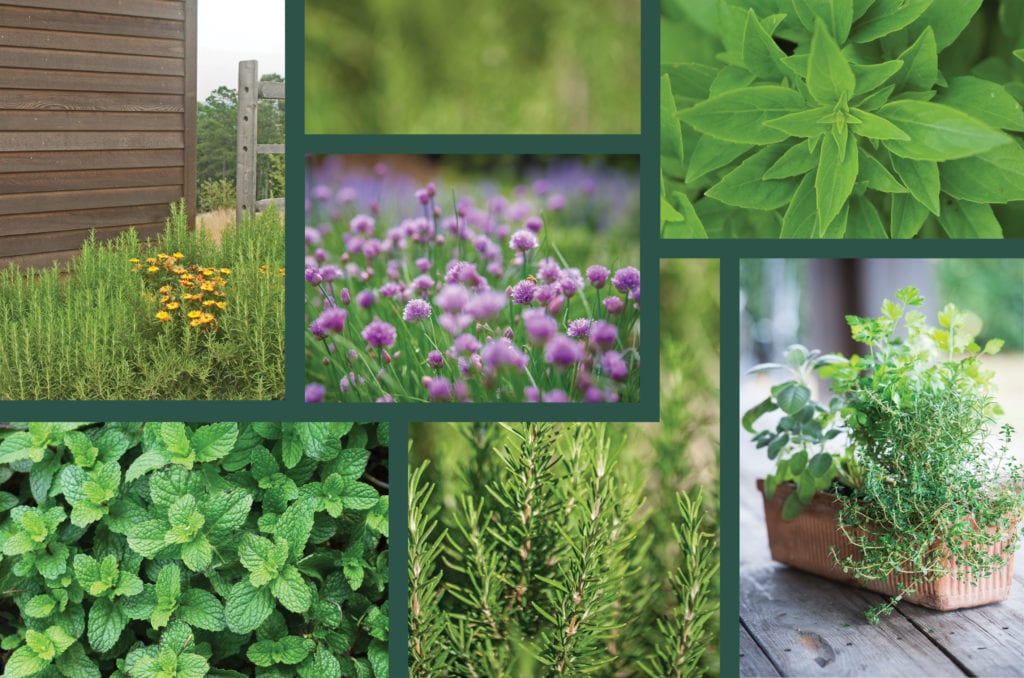Herbs are incredibly useful—and they’re also beautiful and fragrant! I have herbs everywhere throughout the farm: in the vegetable garden, potted in containers and mixed in with flowers. If you’re just getting into growing your own food, herbs are a great place to start. You’ll need to keep a few rules in mind, but otherwise, it takes minimal effort. Put your bed or containers in full sun or at least half-day sun. Plant the herbs in soil that drains well and is consistently moist but not soggy. I keep a saucer under my containers to keep the soil moist and also place the tags near the plant so I can keep track of each one. The following are some of my favorite herbs to grow.
Basil is a favorite annual for summer. If you like to cook, grow an assortment, from the tiny leafed, spicy globe and boxwood types to the cinnamon-spiced Thai and classic sweet Italian basil. Set your plants out about two weeks after the last frost when the days are warm; basil can’t stand cold weather. Add plenty of organic nutrients from compost, blood meal or cottonseed meal to the soil. Because you’ll harvest often and it is continuously replacing leaves, feed every couple of weeks with an all-purpose, liquid plant food. Most grow about 2 feet tall, but the little-leafed ones are shorter.
Basil needs well-drained soil and full sun but appreciates afternoon shade in hot climates. Water deeply during dry spells and water potted plants more because they dry out faster. Avoid splashing water on the leaves to prevent leaf spots and sunburn. In fall, bring potted basil inside.
mint
Mint requires the least amount of care. I grow two main varieties, spearmint and peppermint, distinguished by their smell, stems and leaves. Over time, your plants might become tall and spindly, but just cut them back. This will cause the plants to produce lots of new tender shoots, where you’ll find the best flavor. To keep peppermint from invading your garden, plant it in containers or a bottomless plastic nursery pot that is at least 10 inches tall to confine the underground stems.
Thyme is easy to grow in the garden or a container. I recommend starting with a planting or a cutting from a friend. It should go into the ground a couple of weeks before the last frost, when the soil is around 70°F. Thyme thrives in the sun and requires little water after the initial watering.
Growing it in containers allows you to reproduce the well-drained soil conditions of the Mediterranean slopes where it grows wild. Even a plant as durable as thyme can be a total bust if you don’t amend the soil with plenty of sand and pea gravel to minimize the effects of excessive moisture.
Thyme is evergreen in most zones, but when it gets cold, I cover the plants with frost blankets to preserve the foliage and help the plant winter over. The more thyme you use, the more it grows. When cutting, leave at least 5 inches of growth so the plant can flourish.
Rosemary is an aromatic, perennial evergreen that prefers a warm, sunny and dry environment. Most varieties will not survive below 15° to 20°F. It is ideally suited for container gardening, or you can grow it next to thyme since their needs are the same. Keep a pot outside your kitchen or plant it, container and all, in the garden. When temperatures begin to drop in autumn, bring it indoors and place near a sunny window (south facing is ideal). Take care not to over-water it because the roots can rot easily. An occasional misting helps if it gets too dry inside.
